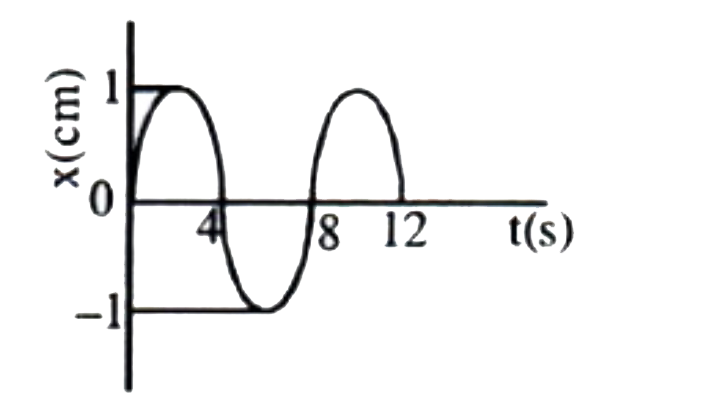Passage I) In simple harmonic motion force acting on a particle is given as F=−4x, total mechanical energy of the particle is 10 J and amplitude of oscillations is 2m, At time t=0 acceleration of the particle is −16ms2. Mass of the particle is 0.5 kg.
At x=+1m, potential energy and kinetic energy of the particle are
2 J and 8 J
8 J and 2 J
6 J and 4 J
4 J and 6 J
The correct Answer is:D
To find the potential energy (PE) and kinetic energy (KE) of the particle at x=+1m, we can follow these steps:
Step 1: Identify the Force Constant K
The force acting on the particle is given by:
F=−4x
From this, we can identify the force constant K:
K=4N/m
Step 2: Calculate the Angular Frequency ω
The angular frequency ω is given by:
ω=√Km
where m=0.5kg. Substituting the values:
ω=√40.5=√8=2√2rad/s
Step 3: Calculate the Velocity v at x=1m
In simple harmonic motion, the velocity v at position x can be calculated using:
v=ω√A2−x2
where A=2m (the amplitude). Substituting the values:
v=2√2√22−12=2√2√4−1=2√2√3=2√6m/s
Step 4: Calculate the Kinetic Energy KE
The kinetic energy is given by:
KE=12mv2
Substituting the mass and the calculated velocity:
KE=12×0.5×(2√6)2=12×0.5×24=6J
Step 5: Calculate the Potential Energy PE
The total mechanical energy E is given as:
E=KE+PE
We know E=10J and KE=6J, so we can find PE:
PE=E−KE=10−6=4J
Final Answer
At x=+1m:
- Potential Energy PE=4J
- Kinetic Energy KE=6J
---
The force acting on the particle is given by:
F=−4x
From this, we can identify the force constant K:
K=4N/m
The angular frequency ω is given by:
ω=√Km
where m=0.5kg. Substituting the values:
ω=√40.5=√8=2√2rad/s
In simple harmonic motion, the velocity v at position x can be calculated using:
v=ω√A2−x2
where A=2m (the amplitude). Substituting the values:
v=2√2√22−12=2√2√4−1=2√2√3=2√6m/s
The kinetic energy is given by:
KE=12mv2
Substituting the mass and the calculated velocity:
KE=12×0.5×(2√6)2=12×0.5×24=6J
The total mechanical energy E is given as:
E=KE+PE
We know E=10J and KE=6J, so we can find PE:
PE=E−KE=10−6=4J
At x=+1m:
- Potential Energy PE=4J
- Kinetic Energy KE=6J
Topper's Solved these Questions
- SIMPLE HARMONIC MOTIONBOOK - DC PANDEY ENGLISHCHAPTER - SIMPLE HARMONIC MOTIONEXERCISE - Matrix matching type questions
13 Videos
- SIMPLE HARMONIC MOTIONBOOK - DC PANDEY ENGLISHCHAPTER - SIMPLE HARMONIC MOTIONEXERCISE - Integer type questions
14 Videos
- SIMPLE HARMONIC MOTIONBOOK - DC PANDEY ENGLISHCHAPTER - SIMPLE HARMONIC MOTIONEXERCISE - More than one option is correct
50 Videos
- SEMICONDUCTORS AND ELECTRONIC DEVICESBOOK - DC PANDEY ENGLISHCHAPTER - SEMICONDUCTORS AND ELECTRONIC DEVICESEXERCISE - More than One Option is Correct
3 Videos
- SOLVD PAPERS 2017 NEET, AIIMS & JIPMERBOOK - DC PANDEY ENGLISHCHAPTER - SOLVD PAPERS 2017 NEET, AIIMS & JIPMEREXERCISE - Solved paper 2018(JIPMER)
38 Videos
Similar Questions
Passage I) In simple harmonic motion force acting on a particle is given as F=−4x, total mechanical energy of the particle is 10 J and amplitude of oscillations is 2m, At time t=0 acceleration of the particle is −16ms2. Mass of the particle is 0.5 kg.
Potential energy of the particle at mean position is
View SolutionPassage I) In simple harmonic motion force acting on a particle is given as F=−4x, total mechanical energy of the particle is 10 J and amplitude of oscillations is 2m, At time t=0 acceleration of the particle is −16ms2. Mass of the particle is 0.5 kg.
Displacement time equation equation of the particle is
View SolutionForce acting on a particle is F=−8x in S.H.M. The amplitude of oscillation is 2 (in m) and mass of the particle is 0.5 kg. The total mechanical energy of the particle is 20 J. Find the potential energy of the particle in mean position (in J).
View SolutionIn simple harmonic motion of a particle, maximum kinetic energy is 40 J and maximum potential energy is 60 J. then
View SolutionTwo simple harmonic motions y1=Asinωt and y2 = Acosωt are superimposed on a particle of mass m. The total mechanical energy of the particle is
View SolutionKinetic energy of a particle moving in a straight line varies with time t as K=4t2. The force acting on the particle
View SolutionA particle of mass mo moves with a speed C2. Calculate its mass, momentum, total energy and kinetic energy.
View SolutionIf particle is excuting simple harmonic motion with time period T, then the time period of its total mechanical energy is :-
View SolutionThe x-t graph of a particle undergoing simple harmonic motion is shown below. The acceleration of the particle at t=23s is

View SolutionA time varying force, F=2t is acting on a particle of mass 2kg moving along x-axis. velocity of the particle is 4m/s along negative x-axis at time t=0. Find the velocity of the particle at the end of 4s.
View Solution
